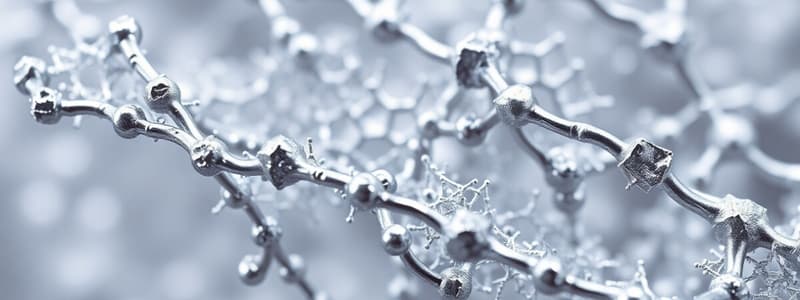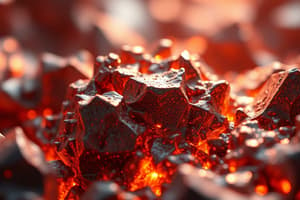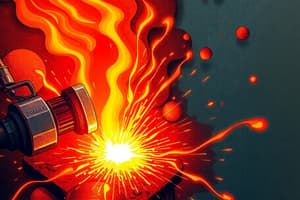Podcast
Questions and Answers
What is the term used for the process in which metal solidifies into many small crystals rather than a single crystal?
What is the term used for the process in which metal solidifies into many small crystals rather than a single crystal?
- Homogeneous solidification
- Microcrystalline formation
- Nucleation spread
- Heterogeneous nucleation (correct)
Which of the following best describes the effects of rapid solidification on grain size?
Which of the following best describes the effects of rapid solidification on grain size?
- It leads to coarse and irregular grains.
- It has no effect on grain size.
- It produces a larger grain size.
- It typically leads to a finer grain size. (correct)
What are the imperfections in the crystal structure of metals called that occur due to the interaction of grains?
What are the imperfections in the crystal structure of metals called that occur due to the interaction of grains?
- Phase boundaries
- Crystal defects
- Grain boundaries (correct)
- Atomic voids
What is the primary method by which the microstructure of a metal can be visually examined?
What is the primary method by which the microstructure of a metal can be visually examined?
In wrought processes, what is the predominant characteristic of the grain structure of deformed metals?
In wrought processes, what is the predominant characteristic of the grain structure of deformed metals?
What is the purpose of using etchants when examining metal microstructures?
What is the purpose of using etchants when examining metal microstructures?
Why are alloys preferred over pure metals in practical applications?
Why are alloys preferred over pure metals in practical applications?
What primarily influences the variation in properties of metals at the microstructural level?
What primarily influences the variation in properties of metals at the microstructural level?
What is the maximum copper solubility in silver as indicated in the Ag-Cu system phase diagram?
What is the maximum copper solubility in silver as indicated in the Ag-Cu system phase diagram?
What is the significance of the eutectic point in the Ag-Cu system?
What is the significance of the eutectic point in the Ag-Cu system?
What process occurs at 723°C in the Fe-Cu system phase diagram?
What process occurs at 723°C in the Fe-Cu system phase diagram?
During rapid cooling of alloys, what is likely to happen to the phase with the highest melting temperature?
During rapid cooling of alloys, what is likely to happen to the phase with the highest melting temperature?
What structural feature is commonly observed in the final solid structure due to non-equilibrium conditions?
What structural feature is commonly observed in the final solid structure due to non-equilibrium conditions?
What does compositional segregation refer to in the context of alloy solidification?
What does compositional segregation refer to in the context of alloy solidification?
Which of the following statements about phase diagrams is correct?
Which of the following statements about phase diagrams is correct?
Which type of phase involves a mixture of more than one metallic element?
Which type of phase involves a mixture of more than one metallic element?
What best describes equiaxed grain structures?
What best describes equiaxed grain structures?
Which of the following accurately defines solidification?
Which of the following accurately defines solidification?
In the context of alloys, what is true about a binary alloy?
In the context of alloys, what is true about a binary alloy?
Which grain structure is characterized by its elongation along a specific direction?
Which grain structure is characterized by its elongation along a specific direction?
What does the freezing diagram illustrate?
What does the freezing diagram illustrate?
Which of the following is NOT a type of grain structure?
Which of the following is NOT a type of grain structure?
What effect does etching have on a metal's surface as shown in the figures?
What effect does etching have on a metal's surface as shown in the figures?
How do grain structures change during solidification?
How do grain structures change during solidification?
What is true about intermetallic compounds in relation to phases?
What is true about intermetallic compounds in relation to phases?
What characterizes the solidification process of pure metals compared to alloys?
What characterizes the solidification process of pure metals compared to alloys?
In the copper-nickel system, what does the phase diagram allow you to determine?
In the copper-nickel system, what does the phase diagram allow you to determine?
Which temperature is defined as the liquidus in the cooling curve of alloys?
Which temperature is defined as the liquidus in the cooling curve of alloys?
What thermodynamic concept is reflected in both the cooling curves and the phase diagrams?
What thermodynamic concept is reflected in both the cooling curves and the phase diagrams?
What is a key reason why copper and silver exhibit partial solid solubility in each other?
What is a key reason why copper and silver exhibit partial solid solubility in each other?
What is a characteristic difference between the solidus and liquidus in alloy cooling curves?
What is a characteristic difference between the solidus and liquidus in alloy cooling curves?
Why do alloys solidify over a range of temperatures rather than at a single temperature like pure metals?
Why do alloys solidify over a range of temperatures rather than at a single temperature like pure metals?
What happens to latent heat during the phase transition from liquid to solid?
What happens to latent heat during the phase transition from liquid to solid?
What does a mixture of 50Cu 50Ni at 1300°C primarily consist of?
What does a mixture of 50Cu 50Ni at 1300°C primarily consist of?
What must be true for a substitutional solid solution to form?
What must be true for a substitutional solid solution to form?
In an interstitial solid solution, what is a requirement for the solute atom's size relative to the solvent atom?
In an interstitial solid solution, what is a requirement for the solute atom's size relative to the solvent atom?
Which of the following is an example of an intermetallic compound?
Which of the following is an example of an intermetallic compound?
What does a binary phase diagram represent?
What does a binary phase diagram represent?
Which type of solid solution can be described as atoms fitting into the spaces between solvent atoms?
Which type of solid solution can be described as atoms fitting into the spaces between solvent atoms?
Which of the following pairs can form a substitutional solid solution?
Which of the following pairs can form a substitutional solid solution?
What is true about the atomic diameters of gold (Au) and copper (Cu)?
What is true about the atomic diameters of gold (Au) and copper (Cu)?
Which of the following statements accurately describes the atomic sizes of metals that can form substitutional solid solutions?
Which of the following statements accurately describes the atomic sizes of metals that can form substitutional solid solutions?
Which metal is widely known to form interstitial solid solutions when combined with iron?
Which metal is widely known to form interstitial solid solutions when combined with iron?
Which of the following characteristics is NOT required for forming a substitutional solid solution?
Which of the following characteristics is NOT required for forming a substitutional solid solution?
Flashcards
Unit Cell
Unit Cell
The smallest repeating unit in a crystalline structure.
Homogeneous Nucleation
Homogeneous Nucleation
The process of forming a new crystal from a liquid, typically initiated by atoms losing thermal energy and forming a unit cell.
Heterogeneous Nucleation
Heterogeneous Nucleation
The process of forming a new crystal from a liquid, initiated by impurities within the metal.
Grain Boundaries
Grain Boundaries
Signup and view all the flashcards
Wrought Metals
Wrought Metals
Signup and view all the flashcards
Working (Metals)
Working (Metals)
Signup and view all the flashcards
Alloy
Alloy
Signup and view all the flashcards
Microstructure
Microstructure
Signup and view all the flashcards
What is a 'phase' in materials science?
What is a 'phase' in materials science?
Signup and view all the flashcards
What is an alloy?
What is an alloy?
Signup and view all the flashcards
What is the difference between a binary and a ternary alloy?
What is the difference between a binary and a ternary alloy?
Signup and view all the flashcards
What is an equiaxed grain structure?
What is an equiaxed grain structure?
Signup and view all the flashcards
What is a radial grain structure?
What is a radial grain structure?
Signup and view all the flashcards
What is solidification?
What is solidification?
Signup and view all the flashcards
What is homogeneous nucleation?
What is homogeneous nucleation?
Signup and view all the flashcards
What is heterogeneous nucleation?
What is heterogeneous nucleation?
Signup and view all the flashcards
What is a freezing diagram?
What is a freezing diagram?
Signup and view all the flashcards
What are grain boundaries?
What are grain boundaries?
Signup and view all the flashcards
Substitutional Solid Solution
Substitutional Solid Solution
Signup and view all the flashcards
Interstitial Solid Solution
Interstitial Solid Solution
Signup and view all the flashcards
Intermetallic Compound
Intermetallic Compound
Signup and view all the flashcards
Phase Diagram
Phase Diagram
Signup and view all the flashcards
Binary Phase Diagram
Binary Phase Diagram
Signup and view all the flashcards
Solid Solubility
Solid Solubility
Signup and view all the flashcards
Solubility Limit
Solubility Limit
Signup and view all the flashcards
Electronegativity Difference
Electronegativity Difference
Signup and view all the flashcards
Ionic Bonding Tendency
Ionic Bonding Tendency
Signup and view all the flashcards
Crystal Structure Tendency
Crystal Structure Tendency
Signup and view all the flashcards
Eutectic Point
Eutectic Point
Signup and view all the flashcards
Eutectoid Transformation
Eutectoid Transformation
Signup and view all the flashcards
Solidification
Solidification
Signup and view all the flashcards
Compositional Segregation
Compositional Segregation
Signup and view all the flashcards
Dendrites
Dendrites
Signup and view all the flashcards
Liquidus
Liquidus
Signup and view all the flashcards
Solidus
Solidus
Signup and view all the flashcards
Latent Heat of Fusion
Latent Heat of Fusion
Signup and view all the flashcards
Solubility
Solubility
Signup and view all the flashcards
Cooling Curve of a Pure Metal
Cooling Curve of a Pure Metal
Signup and view all the flashcards
Cooling Curve of an Alloy
Cooling Curve of an Alloy
Signup and view all the flashcards
Equilibrium Phase Diagram
Equilibrium Phase Diagram
Signup and view all the flashcards
Partial Solid Solubility
Partial Solid Solubility
Signup and view all the flashcards
Composition Range in Cu-Ni Alloys
Composition Range in Cu-Ni Alloys
Signup and view all the flashcards
Phase Diagram Construction
Phase Diagram Construction
Signup and view all the flashcards




